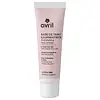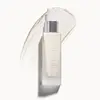What's inside
What's inside
 Key Ingredients
Key Ingredients

 Benefits
Benefits

 Concerns
Concerns

 Ingredients Side-by-side
Ingredients Side-by-side

Water
Skin ConditioningCaprylic/Capric Triglyceride
MaskingCetearyl Alcohol
EmollientC10-18 Triglycerides
EmollientTapioca Starch
Mica
Cosmetic ColorantPentylene Glycol
Skin ConditioningGlycerin
HumectantGlyceryl Stearate
EmollientJojoba Esters
EmollientGluconolactone
Skin ConditioningHelianthus Annuus Seed Wax
Skin ConditioningSodium Stearoyl Glutamate
CleansingSodium Benzoate
MaskingCaprylyl Glycol
EmollientPotassium Cetyl Phosphate
EmulsifyingXanthan Gum
EmulsifyingSodium Hydroxide
BufferingAloe Barbadensis Leaf Juice Powder
Skin ConditioningCitric Acid
BufferingPolyglycerin-3
HumectantCalcium Gluconate
HumectantTocopherol
AntioxidantCI 77891
Cosmetic ColorantCI 77491
Cosmetic ColorantWater, Caprylic/Capric Triglyceride, Cetearyl Alcohol, C10-18 Triglycerides, Tapioca Starch, Mica, Pentylene Glycol, Glycerin, Glyceryl Stearate, Jojoba Esters, Gluconolactone, Helianthus Annuus Seed Wax, Sodium Stearoyl Glutamate, Sodium Benzoate, Caprylyl Glycol, Potassium Cetyl Phosphate, Xanthan Gum, Sodium Hydroxide, Aloe Barbadensis Leaf Juice Powder, Citric Acid, Polyglycerin-3, Calcium Gluconate, Tocopherol, CI 77891, CI 77491
Lavandula Angustifolia Flower Water
Skin ConditioningOctyldodecanol
EmollientC10-18 Triglycerides
EmollientOlea Europaea Fruit Oil
MaskingMica
Cosmetic ColorantSqualane
EmollientJojoba Esters
EmollientDisodium Cocoyl Glutamate
CleansingCaprylic/Capric Triglyceride
MaskingHelianthus Annuus Seed Wax
Skin ConditioningTrehalose
HumectantPullulan
Polyglyceryl-6 Distearate
EmulsifyingSodium Hyaluronate
HumectantDioscorea Batatas Extract
AntioxidantAvena Sativa Kernel Extract
AbrasiveSpilanthes Acmella Flower Extract
Skin ConditioningCetyl Alcohol
EmollientPolyglyceryl-3 Beeswax
EmulsifyingAcacia Decurrens Flower Wax
EmollientPolyglycerin-3
HumectantGlycerin
HumectantPollen Extract
EmollientGlycine Soja Oil Unsaponifiables
EmollientOlea Europaea Oil Unsaponifiables
Skin ConditioningTriticum Vulgare Germ Oil Unsaponifiables
EmollientTocopherol
AntioxidantSodium Phytate
Xanthan Gum
EmulsifyingSilver
Cosmetic ColorantGlyceryl Caprylate
EmollientDisodium Capryloyl Glutamate
CleansingSodium Dehydroacetate
PreservativeCitric Acid
BufferingSilica
AbrasiveParfum
MaskingTitanium Dioxide
Cosmetic ColorantCI 77891
Cosmetic ColorantCI 77491
Cosmetic ColorantLavandula Angustifolia Flower Water, Octyldodecanol, C10-18 Triglycerides, Olea Europaea Fruit Oil, Mica, Squalane, Jojoba Esters, Disodium Cocoyl Glutamate, Caprylic/Capric Triglyceride, Helianthus Annuus Seed Wax, Trehalose, Pullulan, Polyglyceryl-6 Distearate, Sodium Hyaluronate, Dioscorea Batatas Extract, Avena Sativa Kernel Extract, Spilanthes Acmella Flower Extract, Cetyl Alcohol, Polyglyceryl-3 Beeswax, Acacia Decurrens Flower Wax, Polyglycerin-3, Glycerin, Pollen Extract, Glycine Soja Oil Unsaponifiables, Olea Europaea Oil Unsaponifiables, Triticum Vulgare Germ Oil Unsaponifiables, Tocopherol, Sodium Phytate, Xanthan Gum, Silver, Glyceryl Caprylate, Disodium Capryloyl Glutamate, Sodium Dehydroacetate, Citric Acid, Silica, Parfum, Titanium Dioxide, CI 77891, CI 77491
Ingredients Explained
These ingredients are found in both products.
Ingredients higher up in an ingredient list are typically present in a larger amount.
C10-18 Triglycerides is a skin conditioning and texture-enhancer.
It is created from glycerin and a mixture of C10-18 fatty acids.
This ingredient improves spreadability and helps thicken a product.
According to manufacturers, it usually comes from vegetable-based saturated fatty acids. Common bases for this ingredient are coconut oil, palm kernel oil, or both.
Due to the melting point being close to skin temperature, it is usually used in lip products.
Triglycerides are a main component of fat in the human body.
Learn more about C10-18 TriglyceridesThis ingredient is an emollient, solvent, and texture enhancer. It is considered a skin-softener by helping the skin prevent moisture loss.
It helps thicken a product's formula and makes it easier to spread by dissolving clumping compounds.
Caprylic Triglyceride is made by combining glycerin with coconut oil, forming a clear liquid.
While there is an assumption Caprylic Triglyceride can clog pores due to it being derived from coconut oil, there is no research supporting this.
Learn more about Caprylic/Capric TriglycerideCi 77491 is also hydrated iron III oxide. It's sole purpose is to give a red/pink hue to products.
Iron III oxides are classified as inorganic chemicals for coloring.
Synthetically created Ci 77491 is considered safer than those naturally found. This is because the synthetically created version may contain less impurities. Iron oxides are generally non-toxic and non-allergenic.
Learn more about CI 77491Ci 77891 is a white pigment from Titanium dioxide. It is naturally found in minerals such as rutile and ilmenite.
It's main function is to add a white color to cosmetics. It can also be mixed with other colors to create different shades.
Ci 77891 is commonly found in sunscreens due to its ability to block UV rays.
Learn more about CI 77891Citric Acid is an alpha hydroxy acid (AHA) naturally found in citrus fruits like oranges, lemons, and limes.
Like other AHAs, citric acid can exfoliate skin by breaking down the bonds that hold dead skin cells together. This helps reveal smoother and brighter skin underneath.
However, this exfoliating effect only happens at high concentrations (20%) which can be hard to find in cosmetic products.
Due to this, citric acid is usually included in small amounts as a pH adjuster. This helps keep products slightly more acidic and compatible with skin's natural pH.
In skincare formulas, citric acid can:
While it can provide some skin benefits, research shows lactic acid and glycolic acid are generally more effective and less irritating exfoliants.
Most citric acid used in skincare today is made by fermenting sugars (usually from molasses). This synthetic version is identical to the natural citrus form but easier to stabilize and use in formulations.
Read more about some other popular AHA's here:
Learn more about Citric AcidGlycerin is already naturally found in your skin. It helps moisturize and protect your skin.
A study from 2016 found glycerin to be more effective as a humectant than AHAs and hyaluronic acid.
As a humectant, it helps the skin stay hydrated by pulling moisture to your skin. The low molecular weight of glycerin allows it to pull moisture into the deeper layers of your skin.
Hydrated skin improves your skin barrier; Your skin barrier helps protect against irritants and bacteria.
Glycerin has also been found to have antimicrobial and antiviral properties. Due to these properties, glycerin is often used in wound and burn treatments.
In cosmetics, glycerin is usually derived from plants such as soybean or palm. However, it can also be sourced from animals, such as tallow or animal fat.
This ingredient is organic, colorless, odorless, and non-toxic.
Glycerin is the name for this ingredient in American English. British English uses Glycerol/Glycerine.
Learn more about GlycerinHelianthus Annuus Seed Wax is created from the common sunflower.
Sunflower seed wax is made up of long chain non-glyceride esters, a small amount of fatty alcohols, and fatty acids.
This ingredient is often used to enhance the texture of products. The fatty acid properties also help hydrate the skin.
Learn more about Helianthus Annuus Seed WaxJojoba Esters is a wax created from Jojoba oil. It is an emollient and film-forming ingredient. In bead form, it is an exfoliator.
This ingredient has high oxidative stability, meaning it doesn't break down when exposed to oxygen.
Its similarity to our skin's natural oils makes it a great emollient. Emollients help soften and soothe our skin by creating a barrier on top. This barrier helps trap moisture in, keeping skin hydrated.
It is created using either the hydrogenation or transesterification processes on jojoba oil.
Learn more about Jojoba EstersMica is a naturally occurring mineral used to add shimmer and color in cosmetics. It can also help improve the texture of a product or give it an opaque, white/silver color.
Serecite is the name for very fine but ragged grains of mica.
This ingredient is often coated with metal oxides like titanium dioxide. Trace amounts of heavy metals may be found in mica, but these metals are not harmful in our personal products.
Mica has been used since prehistoric times throughout the world. Ancient Egyptian, Indian, Greek, Roman, Aztec, and Chinese civilizations have used mica.
Learn more about MicaPolyglycerin-3 is a 3-unit glycerin polymer.
Like glycerin, this ingredient is a humectant. Humectants help hydrate your skin by drawing water to it.
Having moisturized skin helps improve the skin barrier. Your skin barrier helps protect against irritants and bacteria.
Learn more about Polyglycerin-3Tocopherol (also known as Vitamin E) is a common antioxidant used to help protect the skin from free-radicals and strengthen the skin barrier. It's also fat soluble - this means our skin is great at absorbing it.
Vitamin E also helps keep your natural skin lipids healthy. Your lipid skin barrier naturally consists of lipids, ceramides, and fatty acids. Vitamin E offers extra protection for your skin’s lipid barrier, keeping your skin healthy and nourished.
Another benefit is a bit of UV protection. Vitamin E helps reduce the damage caused by UVB rays. (It should not replace your sunscreen). Combining it with Vitamin C can decrease sunburned cells and hyperpigmentation after UV exposure.
You might have noticed Vitamin E + C often paired together. This is because it is great at stabilizing Vitamin C. Using the two together helps increase the effectiveness of both ingredients.
There are often claims that Vitamin E can reduce/prevent scarring, but these claims haven't been confirmed by scientific research.
Learn more about TocopherolXanthan gum is used as a stabilizer and thickener within cosmetic products. It helps give products a sticky, thick feeling - preventing them from being too runny.
On the technical side of things, xanthan gum is a polysaccharide - a combination consisting of multiple sugar molecules bonded together.
Xanthan gum is a pretty common and great ingredient. It is a natural, non-toxic, non-irritating ingredient that is also commonly used in food products.
Learn more about Xanthan Gum